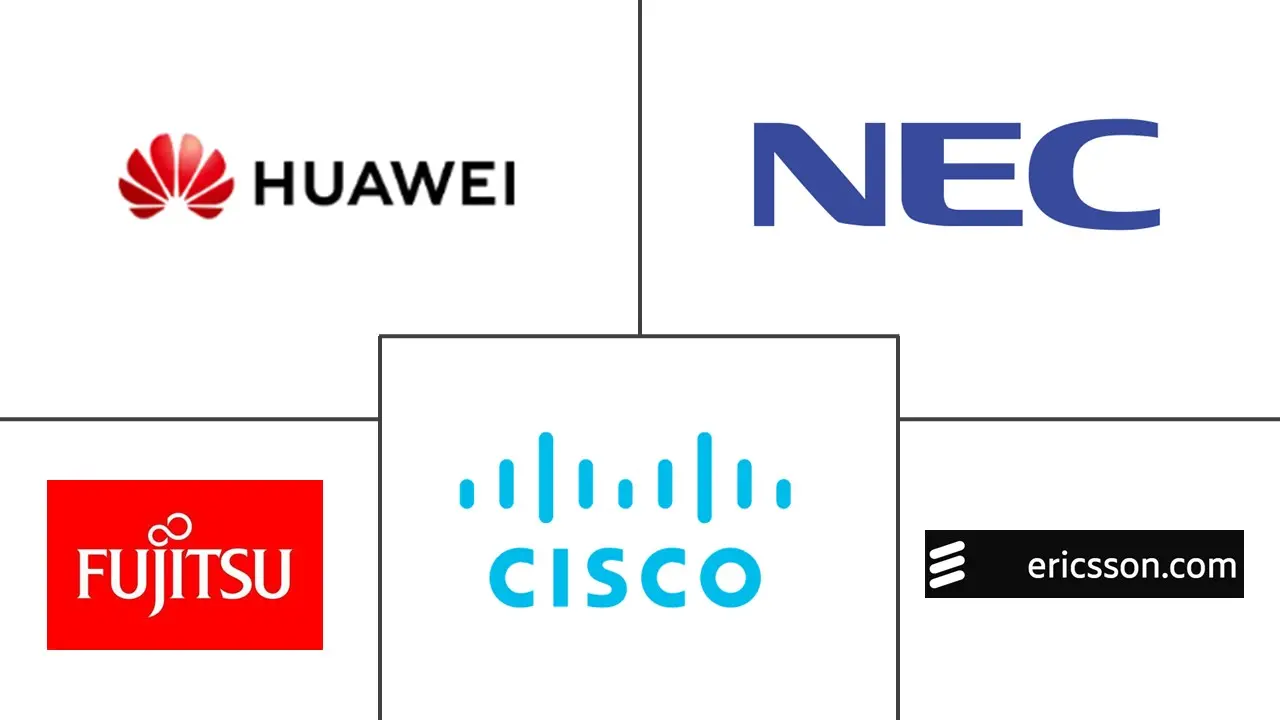Mobile Backhaul Market Size and Share
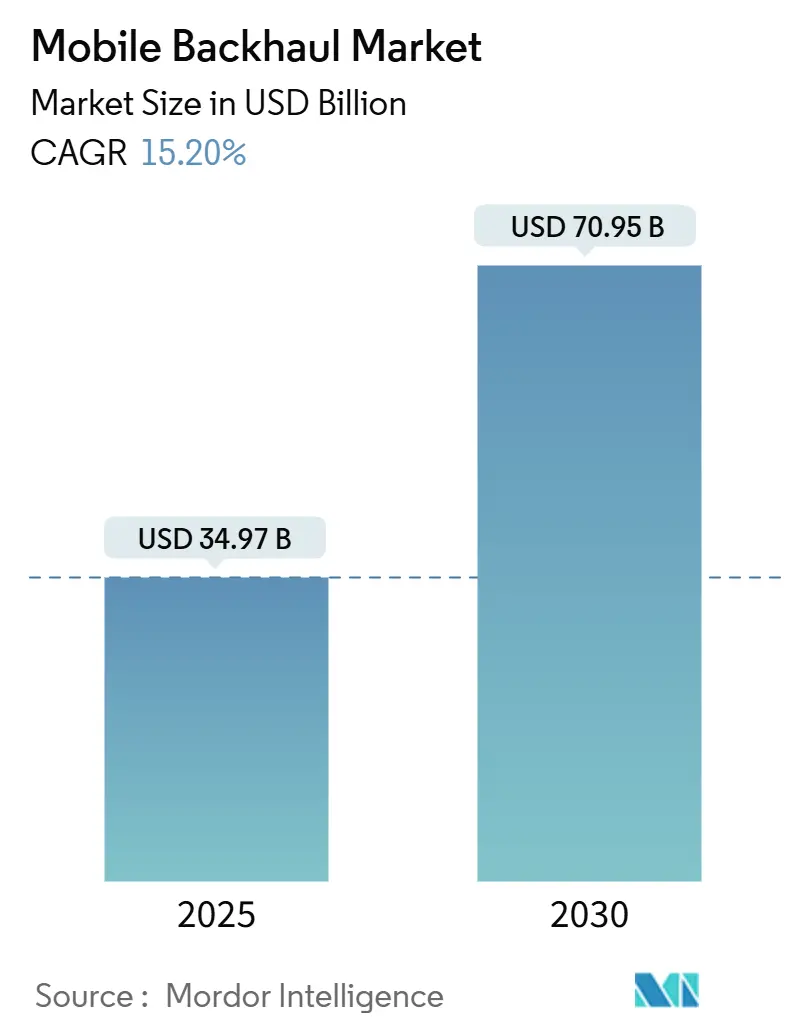
Mobile Backhaul Market Analysis by Mordor Intelligence
The Mobile Backhaul Market size is estimated at USD 34.97 billion in 2025, and is expected to reach USD 70.95 billion by 2030, at a CAGR of 15.20% during the forecast period (2025-2030).
Growth is propelled by escalating smartphone penetration, the sharp rise in video streaming, and dense 5G rollouts that demand 10 Gbps and soon 100 Gbps per cell per site capacity. Operators are swapping copper lines for fiber and high-capacity wireless links, while neutral-host models reduce duplication as 5G investments top USD 1.1 trillion between 2020 and 2025[1]EnerSys White Paper, “Powering 5G: Challenges and Solutions,” enersys.com. Open architectures, software-defined transport, and edge compute place new performance and security pressures on backhaul, yet they can lower life-cycle costs through commercial off-the-shelf hardware. Asia Pacific leads with a 35% revenue contribution and shows the fastest regional CAGR at 17.3% as China, Japan, South Korea, and India install millions of small cells. Operators everywhere now blend fiber’s scale with microwave, millimeter-wave, and low-Earth-orbit (LEO) satellite hops to fill coverage gaps and accelerate rollouts.
Key Report Takeaways
- By deployment, wired links commanded 55% of the mobile backhaul market share in 2024; wireless backhaul is projected to outpace at a 16.4% CAGR to 2030.
- By equipment type, microwave radios held 41% of the mobile backhaul market size in 2024; small-cell backhaul equipment is advancing at a 17.4% CAGR through 2030.
- By service type, managed services accounted for 49% of the mobile backhaul market share in 2024 and are expanding at a 16.4% CAGR.
- By network architecture, Cloud RAN/fronthaul is the fastest-growing segment at a 16.8% CAGR, while macro-cell backhaul remains the largest.
- By geography, Asia Pacific led with 35% revenue in 2024 and is set to post a 17.3% CAGR to 2030.
Global Mobile Backhaul Market Trends and Insights
Drivers Impact Analysis
| Driver | (~) % Impact on CAGR Forecast | Geographic Relevance | Impact Timeline |
|---|---|---|---|
| Mobile data traffic & smartphone adoption | +5.30% | Global, strongest in Asia Pacific | Medium term (2-4 years) |
| Rapid 5G rollout & densification | +4.70% | North America, Europe, East Asia | Short term (≤ 2 years) |
| Cloud-native and Open RAN architectures | +2.80% | North America, Europe, and advanced Asian markets | Medium term (2-4 years) |
| Satellite LEO backhaul for rural reach | +1.60% | Rural zones worldwide | Long term (≥ 4 years) |
| Fiber leasing by utilities & private networks | +1.10% | North America, Europe | Medium term (2-4 years) |
| Source: Mordor Intelligence | |||
Growing Mobile Data Traffic & Smartphone Adoption
Average monthly data per smartphone is forecast to soar from 21 GB in 2023 to 56 GB by 2029, with video expected to account for 75% of mobile traffic. Regional divergence is emerging: North American users may hit 66 GB per month while Sub-Saharan Africa lingers near 23 GB, forcing operators to engineer country-specific backhaul mixes. Hybrid topologies that splice fiber trunks with high-band microwave hops now dominate urban densification because they meet capacity needs without prolonged street-dig permitting. Small-cell proliferation adds thousands of short-haul links, prompting fresh investment in automated network-management platforms that can tune capacity per site in real time.
Rapid 5G Rollout Driving Capacity Needs
Base-station density is climbing from 4–5 to 40–50 sites per km² in 5G clusters, multiplying backhaul terminations. China alone is building more than 600,000 5G macro and small cells, a count projected to outstrip 4G by 1.3–1.5 times [2]Gelonghui Research, “China 5G Base Station Build-out Tracker,” gelonghui.com. Each 5G cell now requires 10 Gbps uplinks and stringent latency of sub-5 ms, accelerating the adoption of 70/80 GHz E-band radios and time-sensitive networking over fiber. Capital stress is nudging many operators toward shared towers and leased dark fiber, lowering up-front costs while ensuring upgrade paths to 100 Gbps interfaces.
Cloud-Native & Open RAN Architectures
Virtualized RAN disaggregates radio, transport, and core functions, letting carriers use standardized servers instead of proprietary appliances. Early deployments report double-digit cost savings and faster feature rollouts, yet they introduce multi-vendor integration hurdles and wider attack surfaces. Operators increasingly source best-of-breed radios, switches, and timing units, then rely on managed backhaul providers to orchestrate performance. Open transport interfaces such as eCPRI unlock statistical multiplexing that trims fronthaul bit-rates while preserving latency targets for massive-MIMO beamforming.
Satellite LEO Backhaul for Rural Reach
LEO constellations like Starlink demonstrate 102 Mbps downlink and 18 ms latency, enabling reliable cell-site to backhaul where trenching fiber would cost multiples more. Service providers in sub-Saharan Africa and the Pacific islands are offering bundles that combine satellite downlinks with local microwave rings to cut per-site bandwidth expense. Still, a five-year satellite replacement cycle keeps total cost per connected home roughly 45% above fiber over a 30-year horizon. Partnerships between LEO operators and tower companies are emerging to aggregate demand and unlock volume-based pricing.
Restraints Impact Analysis
| Restraint | (≈) % Impact on CAGR Forecast | Geographic Relevance | Impact Timeline |
|---|---|---|---|
| High capex for fiber & spectrum | -2.80% | Global; strongest in developing regions | Medium term (2-4 years) |
| SDN backhaul cybersecurity risks | -1.50% | Developed markets | Long term (≥ 4 years) |
| Source: Mordor Intelligence | |||
High Capex for Fiber & Spectrum Costs
Fiber trenching in dense cities can run beyond USD 100,000 per Kilometer, a figure that climbs sharply where road-opening permits are scarce. Rising electricity prices also double macro-site power draw when 4G and 5G bands overlap, inflating operational overhead. In developing economies, limited access to low-interest financing delays fiber build-outs, forcing carriers to rely on microwave even where long-term economics favor fiber. The result is uneven quality-of-experience across urban and rural divides, hindering digital-inclusion goals.
SDN Backhaul Cybersecurity Risks
NTIA catalogued 1,338 distinct vulnerabilities in early Open RAN pilots, with 46% assessed as high risk[3]National Telecommunications and Information Administration, “Open RAN Security Assessment,” ntia.gov. As control-plane functions move into software, attackers gain new vectors, from misconfigured APIs to poisoned machine-learning models. Carriers are investing in Zero-Trust frameworks and MACsec encryption for fronthaul switching, yet multi-vendor patch cycles still lag. The threat of fines and reputational damage is steering some operators toward specialized security-as-a-service offerings bundled with managed backhaul contracts.
Segment Analysis
By Deployment: Wired Foundations, Wireless Momentum
Fiber-based links constituted 55% of the mobile backhaul market in 2024 due to their unrivalled capacity and low latency. This share translates to the largest deployment slice of the mobile backhaul market size at USD 19.2 billion in 2024. Wireless alternatives, however, are set to post a 16.4% CAGR through 2030, narrowing the gap as urban densification and pop-up events demand rapid turn-ups. Operators mesh 70/80 GHz E-band radios with leased dark fiber trunks, delivering 10 Gbps per hop while avoiding costly civil works.
Hybrid architectures are now standard: fiber remains the preferred medium for core aggregation, but microwave and millimeter-wave serve edge small cells and enterprise venues where permits or geography stall trenching. Emergent W-band and D-band links promise multi-gigabit throughput over 1–2 km, complementing fiber for dense clusters. In sparsely populated regions, operators splice LEO satellite backhaul into microwave rings, creating contiguous coverage without exceeding budget ceilings. This flexibility underpins the long-term competitiveness of the mobile backhaul market.
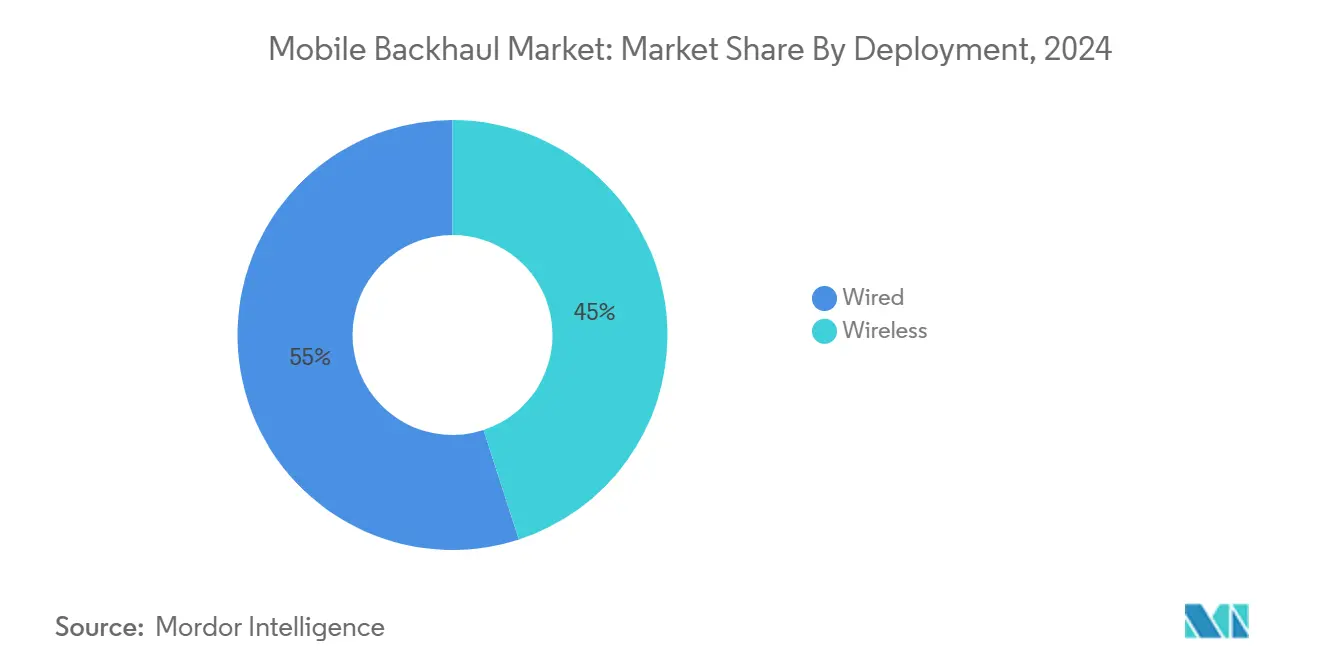
By Equipment Type: Microwave Scale, Small-Cell Innovation
Microwave radios held 41% of the mobile backhaul market size in 2024, reflecting decades of field-proven reliability. Vendors have pushed spectral efficiency to 16 bps/Hz while adding link-bonding schemes that aggregate non-contiguous channels. Small cells backhaul gear, though only a fraction of revenue today, is set for a 17.4% CAGR as stadiums, malls, and transport hubs adopt indoor 5G.
The mobile backhaul market is witnessing a pivot toward integrated access and backhaul (IAB), where a 28 GHz radio simultaneously serves user devices and relays traffic upstream. This reduces rooftop congestion and simplifies zoning. Millimeter-wave chipset advances cut power draw by 30% since 2023, enabling pole-mount and window-mount nodes that require minimum site work. Vendors that bundle self-organizing-network software are winning tenders because they lower truck rolls and optimize link alignment in cluttered environments.
By Service Type: Managed Expertise Takes Root
Managed services captured 49% of the mobile backhaul market share in 2024, reflecting operator preference to offload planning, deployment, and operations. Multi-vendor networks and stringent timing demands make in-house mastery expensive; specialized partners now guarantee service-level agreements down to ±50 ns phase accuracy for 5G TDD sync.
Growth accelerates as enterprises launch private 5G networks and municipalities roll out smart-city sensors that rely on low-latency paths to edge data centers. Providers overlay AI-driven analytics that predict congestion and automate capacity augments, trimming mean-time-to-repair by half versus manual workflows. Professional integration, maintenance, and security services round out the portfolio, ensuring holistic lifecycle coverage and underpinning the expansion of the mobile backhaul market.
By Network Architecture: Cloud RAN Reshapes Topology
Macro-cell backhaul still forms 62% of revenue because wide-area coverage remains indispensable. Yet Cloud RAN/fronthaul links are posting the fastest revenue jump at 16.8% CAGR as operators centralize baseband processing. eCPRI adoption slashes required bandwidth by packing IQ samples more efficiently, lowering transport costs by up to 60% in early trials.
Edge compute further disperses workloads: latency-sensitive functions process at metro data centers, while analytics tasks reside in the regional core. This layered approach forces backhaul planners to engineer deterministic latency paths, spurring investment in segment-routing IPv6 and Sync-E timing over packets. Integrated Access and Backhaul under 3GPP Release 16 adds new flexibility but can overload relay nodes under heavy load, making intelligent slice orchestration a prerequisite for a consistent user experience.
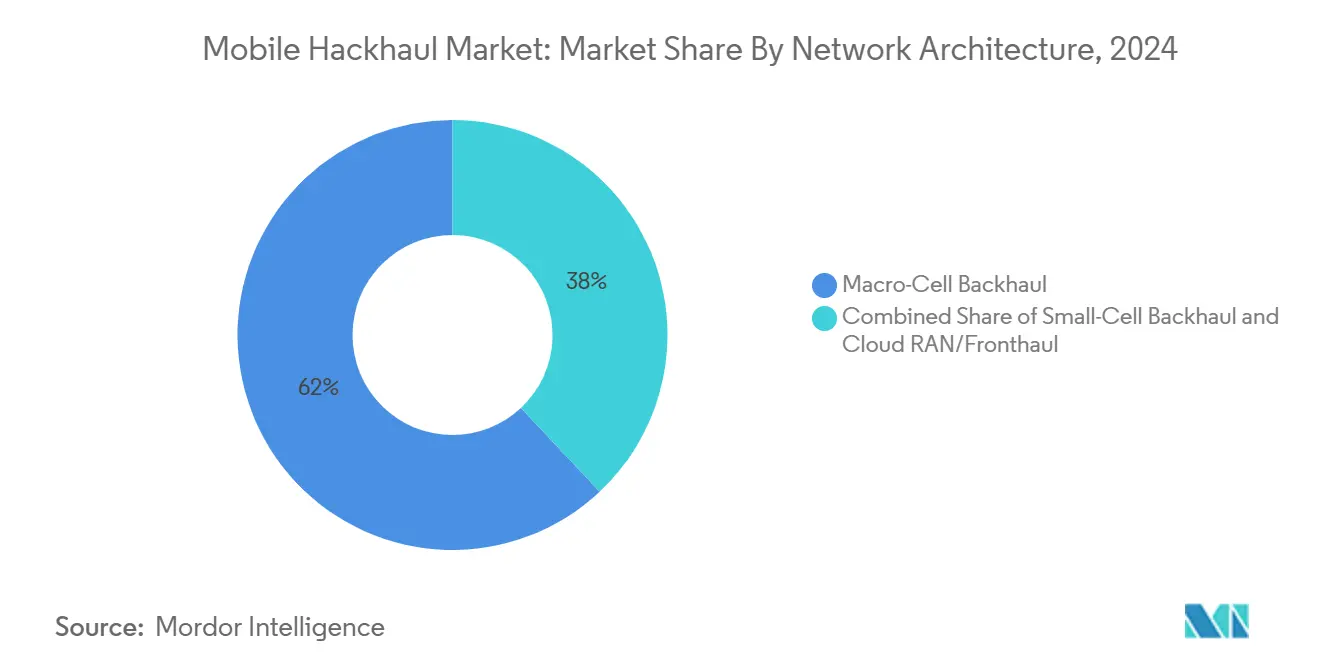
Note: Segment shares of all individual segments available upon report purchase
By End-User: Tower Companies and Neutral Hosts Ascend
Mobile Network Operators held 71% revenue in 2024, yet tower companies and neutral-host providers grew at 17.9% CAGR as shared fiber and power shave duplication. Neutral-host models thrive in airports and metros where separate parallel builds are impractical. The mobile backhaul industry is seeing utilities, railways, and oil majors monetize rights-of-way by leasing conduits, turning infrastructure into an asset.
Private enterprises, ports, factories, and mining camps deploy isolated LTE/5G networks for mission-critical operations. These setups require bespoke backhaul tuned for deterministic jitter, galvanizing niche integrators with deep vertical know-how. This broadening customer mix diversifies revenue streams and stabilizes demand cycles for backhaul hardware and services.
Geography Analysis
Asia Pacific commands 35% of the mobile backhaul market, expanding at 17.3% CAGR thanks to outsized 5G investments, state subsidies, and dense urban populations. China, Japan, and South Korea already blanket major cities with standalone 5G, driving steep demand for 10 Gbps microwave hops that skirt excavation bottlenecks. India’s recent spectrum auctions have unleashed a fiber-laying spree along highways and into tier-2 cities, while operators also pilot satellite-plus-microwave hybrids for Himalayan and island coverage. Government schemes that underwrite rural fiber further sustain momentum.
North America, while smaller by volume, leads innovation in virtualized RAN and dark-fiber aggregation. Verizon and T-Mobile bolstered their optical footprints by acquiring regional fiber players in 2024, locking in scalable backhaul to support fixed-wireless access rollouts. The Federal Communications Commission’s USD 9 billion 5G Fund incentivizes cell-site upgrades in remote counties, channeling investments toward microwave and satellite backhaul where terrain hampers trenching. Fixed-mobile convergence accelerates as operators reuse fiber for both gigabit broadband and cell-site uplinks, amplifying return on capital.
Europe’s mature markets balance stringent regulatory reviews with a push for pan-EU 5G corridors. Infrastructure-sharing frameworks lower duplicate capex, while public–private partnerships finance cross-border fiber routes vital for low-latency services such as connected freight. Meanwhile, the Middle East fast-tracks smart-city visions that rely on dense small-cell grids, and African carriers tap LEO constellations to backhaul remote coverage islands. Latin America sees 5G launches in 17 countries, with carriers forming consortia to lease submarine-cable capacity and distribute it inland via microwave chains, weaving resilience into national networks.
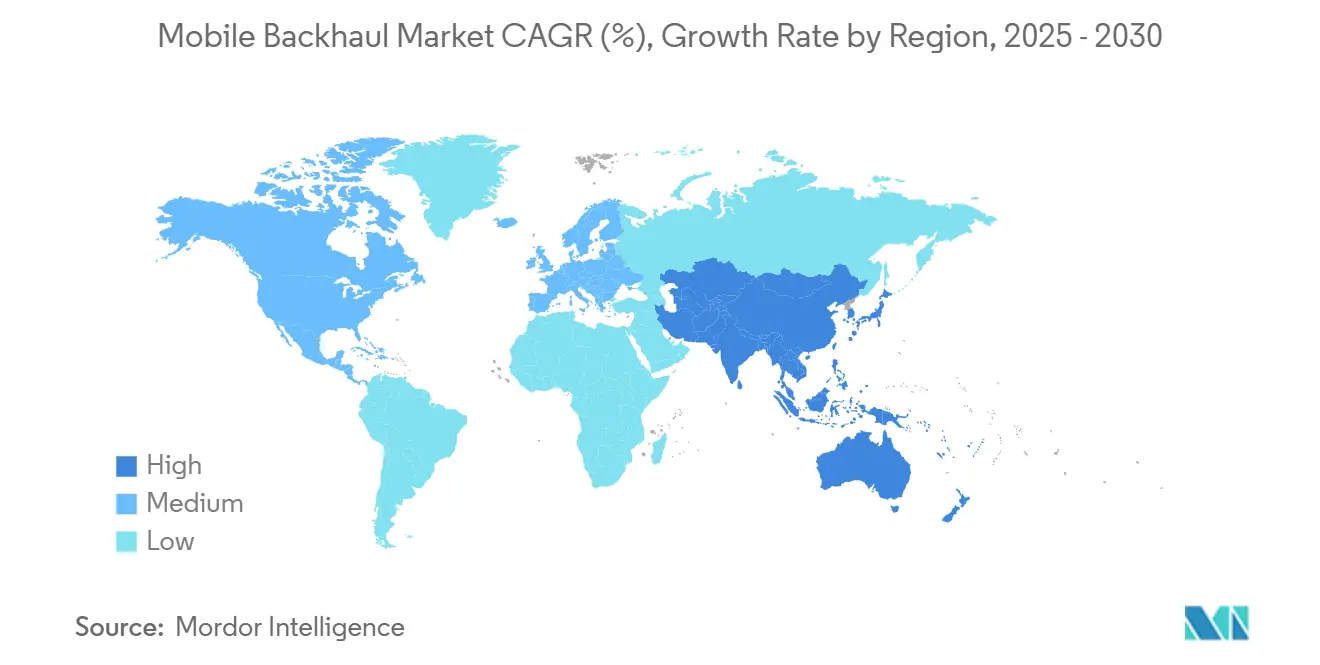
Competitive Landscape
The mobile backhaul market is moderately concentrated: Huawei, Ericsson, Nokia, ZTE, and Cisco together exceed 70% revenue, with Huawei and Ericsson alone controlling 45% of global microwave shipments[4]TelecomLead, “Global Microwave Transmission Market Q1 2025,” telecomlead.com. Regional variance is marked, Nokia and Aviat hold a 56% share in North America, while Ceragon and Huawei lead Asia Pacific with 47%. The rise of Open RAN ecosystems introduces fresh challengers such as NEC, Fujitsu, and Parallel Wireless that bundle radios with transport controllers, eroding incumbents’ lock-in.
Technology is the prime differentiator. Nokia’s pole-mount small-cell with integrated backhaul drew early adopters in dense European metros, while Ericsson partnered with Turkcell to pilot W-band links that triple spectrum resources beyond 80 GHz and achieve 100 Gbps throughput. Ceragon expanded millimeter-wave coverage by snapping up Siklu, gaining compact 70/80 GHz radios suitable for suburban avenues. Vendors also tout AI-driven link-adaptation engines that boost uptime without manual retuning.
Neutral-host fiber operators and tower companies negotiate bulk equipment contracts, intensifying price pressure. Vendors counter by offering lifecycle services from planning and build to security monitoring, binding customers via multi-year agreements. White-space opportunities emerge in rural LEO gateways, private-network backhaul, and edge-compute ingress, where agile specialists can outpace conglomerates weighed down by legacy portfolios.
Mobile Backhaul Industry Leaders
-
Fujitsu Limited
-
NEC Corporation
-
Ericsson Inc.
-
Huawei Technologies
-
Cisco Systems, Inc.
- *Disclaimer: Major Players sorted in no particular order

Recent Industry Developments
- May 2025: Ericsson and Turkcell began W-band backhaul trials delivering 100 Gbps links while cutting energy consumption by 30% compared with E-band.
- May 2025: U Mobile chose Telekom Malaysia for USD 570 million of backhaul services to underpin the nation’s second 5G network.
- April 2025: SES agreed to acquire Intelsat for USD 3.1 billion, creating a multi-orbit satellite carrier with enhanced mobile backhaul reach.
- April 2024: Omnispace and MTN partnered to create an Africa-wide mobile-satellite IoT backhaul network.
Research Methodology Framework and Report Scope
Market Definitions and Key Coverage
Our study defines the mobile backhaul market as the annual spending that mobile-network operators and neutral-host providers incur on capacity services and enabling equipment that move aggregated 2G to 5G traffic from radio sites to core or edge locations over fiber, microwave, millimeter-wave, or satellite links.
Scope exclusion: Fronthaul, dark-fiber leasing for fixed access, and passive optical access deployed only for FTTH are not counted.
Segmentation Overview
- By Deployment
- Wired
- Fiber/Optical
- Copper/DSL
- Wireless
- Microwave
- Millimetre-Wave (E- and V-band)
- Satellite
- Free-Space Optics
- Wired
- By Equipment Type
- Routers and Switches
- Microwave Radios
- Optical Transport Equipment
- Small-Cell Backhaul Equipment
- Others
- By Service Type
- Professional Services
- Managed Services
- Installation and Integration
- Maintenance and Support
- By Network Architecture
- Macro-Cell Backhaul
- Small-Cell Backhaul
- Cloud RAN/Fronthaul
- By End-user
- Mobile Network Operators
- Neutral-Host and Tower Companies
- Internet Service Providers
- Private Enterprises and Utilities
- By Geography
- North America
- United States
- Canada
- Mexico
- South America
- Brazil
- Argentina
- Rest of South America
- Europe
- United Kingdom
- Germany
- France
- Spain
- Italy
- Russia
- Rest of Europe
- Asia-Pacific
- China
- India
- Japan
- South Korea
- Australia
- Rest of Asia-Pacific
- Middle East
- GCC
- Turkey
- Rest of Middle East
- Africa
- South Africa
- Nigeria
- Egypt
- Rest of Africa
- North America
Detailed Research Methodology and Data Validation
Primary Research
Mordor analysts interviewed network-planning heads at mobile operators across Asia, North America, and Europe, tower-co CTOs, transport-equipment product managers, and regional regulators. These conversations clarified typical cost per kilometer for fiber builds, realistic microwave spectrum upgrade timelines, and 5G-driven capacity multipliers, allowing us to confirm or recalibrate desk-research assumptions before locking the baseline.
Desk Research
We began by mining telecom regulator traffic bulletins, the ITU ICT Indicators database, GSMA Intelligence's base-station counts, and spectrum-allocation releases from bodies such as the FCC and Ofcom. Equipment shipment splits were triangulated from vendor 10-Ks, tower-company filings, and import data extracted through UN Comtrade and Volza. Trade bodies like the Small Cell Forum and the Microwave Journal archives supplied technology adoption curves, while D&B Hoovers fed us operator and vendor revenue grids. These publicly available inputs framed the demand pool and price corridors that underpin our model. The sources cited are illustrative; a wider pool was reviewed to cross-check numbers, definitions, and trend inflections.
Market-Sizing & Forecasting
A top-down construct converts active macro and small-cell sites into aggregated backhaul-capacity demand using traffic per site and utilization ratios, which are then valued with blended price per Gbps curves. Select bottom-up cross-checks, such as sampled supplier sales, fiber-route additions, and satellite-capacity leases, align totals within an acceptable variance. Key variables include mobile data traffic growth, site densification rates, fiber share versus microwave share progression, average cost per Mbps, spectrum fee movements, and operator capex intensity. A multivariate regression, stress tested through scenario analysis, projects these drivers to 2030 while flagging tipping points such as Open RAN uptake.
Data Validation & Update Cycle
Outputs pass a two-level analyst review where anomalies versus historical trends, peer benchmarks, and fresh primary inputs are flagged and resolved. Reports refresh yearly with mid-cycle pulses if spectrum auctions, major M&A, or regulatory fee shifts materially change the outlook, ensuring clients receive an up-to-date view with every delivery.
Why Mordor's Mobile Backhaul Baseline Earns Decision-Makers' Trust
Published figures differ because firms mix fronthaul with backhaul, include only wireless or only equipment, or apply distinct currency bases.
By anchoring on operator-level transport spend and keeping service and equipment in scope together, Mordor minimizes such skew.
Benchmark comparison
| Market Size | Anonymized source | Primary gap driver |
|---|---|---|
| USD 34.97 B (2025) | Mordor Intelligence | - |
| USD 46.36 B (2025) | Global Consultancy A | Counts fronthaul, passive optical access, and dark-fiber leasing, inflating total |
| USD 22.61 B (2025) | Trade Journal B | Focuses on wireless backhaul only; excludes fiber builds and managed services |
In summary, differing scopes and driver sets explain headline gaps, yet our disciplined variable selection and annual refresh give stakeholders a balanced, transparent baseline that can be recreated with clear steps and public data checkpoints.
Key Questions Answered in the Report
What is the current size of the mobile backhaul market?
The mobile backhaul market size is USD 34.97 billion in 2025 and is projected to reach USD 70.95 billion by 2030.
Which region is growing fastest in mobile backhaul deployment?
Asia Pacific leads with a 35% revenue share in 2024 and is forecast to expand at a 17.3% CAGR through 2030, propelled by large-scale 5G rollouts.
Why are managed services gaining traction in mobile backhaul?
Managed services already hold 49% revenue because operators prefer outsourcing complex multi-vendor networks, and this segment is growing at 16.4% CAGR.
How does satellite backhaul complement fiber and microwave?
Low-Earth-orbit constellations provide 100 Mbps-plus links with sub-20 ms latency, bridging coverage gaps where fiber trenching is costly or terrain is challenging.
What security challenges arise with SDN and Open RAN backhaul?
NTIA identified over 1,300 vulnerabilities, with 46% high risk, because software-defined control planes increase attack surfaces, necessitating Zero-Trust and MACsec protections.
How will Cloud RAN affect future backhaul requirements?
Cloud RAN centralizes processing, raising fronthaul capacity and latency demands; eCPRI and segment-routing innovations are thus essential to deliver deterministic performance.
Page last updated on:
